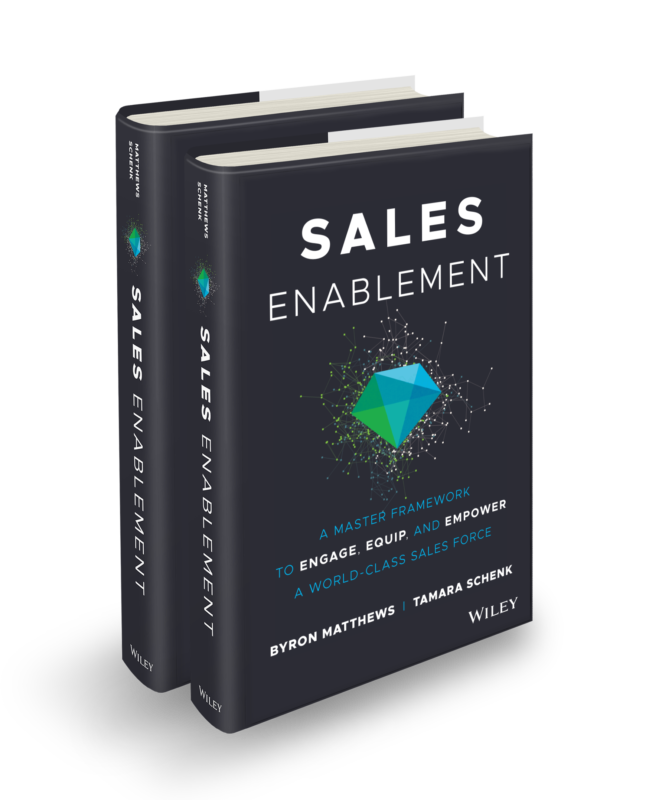This is a blog takeover by Tamara Schenk, research director at CSO Insights and sales enablement leader, analyst, speaker and author.
Sales enablement still means different things to different people. The purpose of any definition is to establish a common understanding and to give a term identity. Here is our definition we developed at CSO Insights, based on research, the work with our clients and based on own experience:
Sales Force Enablement — A strategic, collaborative discipline
designed to increase predictable sales results
by providing consistent, scalable enablement services
that allow customer-facing professionals and their managers
to add value in every customer interaction.
We refer to this as sales force enablement specifically because this involves more than enabling salespeople. Rather, the term sales force encompasses all customer-facing roles and their managers.
Yet, knowing what sales enablement is does not sufficiently equip sales enablement leaders to evolve this function at a strategic level. To achieve that, there must be a sales enablement framework to work from, such as our Sales Enablement Clarity Model.
The 7 Facets of the Sales Enablement Clarity Model
In the latest book I co-authored with Byron Matthews , President and CEO of Miller Heiman Group, Sales Enablement: A Master Framework to Engage, Equip, and Empower A World-Class Sales Force, there is a more in-depth look at implementing sales enablement strategy into your organization, but I will provide an overview of the seven facets of sales enablement that are relevant to evolve sales enablement’s effectiveness.
- Customer Facet: We live in the age of the customer, so salespeople have to be engaged, equipped and empowered to create value at each phase of the customer’s path for all involved buyer roles. Organizations that dynamically align internal processes with the customer’s path can achieve 13.5% better quota attainment results.
- Sponsor, Strategy and Charter Facet: These components are important to evolve sales enablement. We see year-over-year that organizations that operate by a formal enablement charter achieve up to 27.6% better sales productivity. This facet can make or break enablement initiatives, and as such is a major topic of the book.
- Target Audience Facet: Sales enablement ideally addresses not only all customer-facing roles but also their managers, because we have consistently found that organizations with formal and dynamic coaching approaches achieve up to 27.6% better sales performance.
- Effective Sales Enablement Services Facet: This is the only facet visible to the enablement’s target audience. These services cover all kinds of sales training — from skills, methods, processes, products, tools, customer, industries, etc. — to customer-facing content and internal enablement content (playbooks, sales tools) and coaching services. All of these services must be consistent with one another, from tailored value messaging along the customer’s path to differentiation etc., or else the threat of confusion arises.
- Formalized Collaboration Facet: Enablement teams have to collaborate with almost every other function in the organization, so it is essential to clearly define roles and responsibilities per enablement service. For example, marketing is responsible for case studies and has to consult the account executive and enablement function, or enablement is responsible for playbooks and has to consult marketing, product management and L&D for related training service.
- Integrated Technology Facet: Enablement technologies such as content, learning, coaching solutions, should ideally be integrated into the CRM system, which provides a platform for productivity for the sales force. By integrating, salespeople can benefit from a one-stop experience, and your adoption rates will improve significantly.
- Enablement Operations Facet: This is the backbone of sales enablement and unfortunately is often overlooked. A governance model for enablement is essential to keep sponsors engaged and to solve issues that require senior executive involvement. And then processes must be put in place that define how to design, create, localize and provide enablement services, connected to the collaboration model, in order to scale efforts. Lastly, a measurement process needs to be put in place based on the charter, milestones, productivity and performance metrics, as well as leading and lagging indicators.
If you would like to learn more about effective sales enablement strategies and how to implement them in your organization — and to achieve greater revenue performance — Sales Enablement: A Master Framework to Engage, Equip and Empower A World-Class Sales Force is now available on Amazon.

